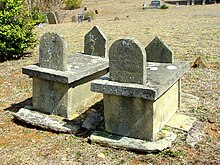Draft:Slot and Tab Tombs
Submission declined on 6 February 2025 by Lemonaka (talk).
Where to get help
How to improve a draft
You can also browse Wikipedia:Featured articles and Wikipedia:Good articles to find examples of Wikipedia's best writing on topics similar to your proposed article. Improving your odds of a speedy review To improve your odds of a faster review, tag your draft with relevant WikiProject tags using the button below. This will let reviewers know a new draft has been submitted in their area of interest. For instance, if you wrote about a female astronomer, you would want to add the Biography, Astronomy, and Women scientists tags. Editor resources
|  |
"Slot and Tab" or "Box" tombs are a type of grave marker found only in upland South folk cemeteries found across north Georgia, south east Tennessee and, south west North Carolina. They are of Scotch-Irish origin and predominantly found at Baptist cemeteries, with a large concentration in the area surrounding Dahlonega, Georgia.[1] The term "slot and tab" refers to the construction of the tomb by use of stone slabs which are notched or tabbed to fit together.[2] The tombs are formed from a box with with sides that are raised from the ground in a box shape. The front and the back of the markers slide through a slots in the top that lock the tomb together. It is believed that this style of tomb originated because cattle were allowed to graze freely and would push over simple grave stones when using them to scratch.[1]
Most of these grave markers were constructed between 1848 and 1889. While the earliest slot-and tab tombs were made of wood, which did not last, the majority were constructed of locally quarried soapstone.[1] Some later tombs were made of granite or marble.[2]

References
[edit]- ^ a b c "Unique tombs tell story of North Hall's history". www.gainesvilletimes.com. Retrieved 2025-02-04.
- ^ a b "Dahlonega's Graves of Gold". www.dahlonega.org. 2016-10-27. Retrieved 2025-02-04.

- in-depth (not just passing mentions about the subject)
- reliable
- secondary
- independent of the subject
Make sure you add references that meet these criteria before resubmitting. Learn about mistakes to avoid when addressing this issue. If no additional references exist, the subject is not suitable for Wikipedia.